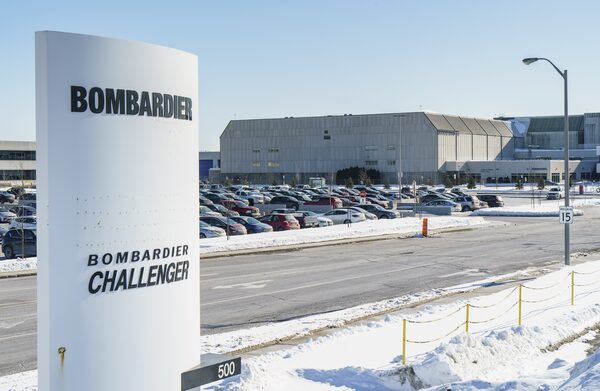
A Bombardier plant stands in Montreal on Feb. 11, 2021.Paul Chiasson/The Canadian Press
Bombardier Inc. was pushed to the brink of bankruptcy largely by the risk it took developing new jets. Now, it is betting it can pivot toward a much lower-risk future by reaping the returns from past investments.
The Montreal-based plane maker on Thursday laid out a strategic game plan for the next five years that will see the company pay down debt, cut costs and push to capture more business, not only from selling jets but servicing them.
It is also looking toward a postpandemic world where the interest in private jet travel that has sprung up during the health crisis could become a significant catalyst for future sales.
Bombardier said it expects to turn free cash flow positive next year and generate more than US$500-million in free cash annually by 2025, as the global economy gradually recovers from the COVID-19 pandemic and the company’s flagship Global 7500 jet starts delivering more earnings power. By the end of the five-year period, it is aiming to deliver earnings before interest, taxes, depreciation and amortization of US$1.5-billion annually on revenues of US$7.5-billion, with an EBITDA margin of 20 per cent.
Investors have heard optimistic financial forecasts before from Bombardier only to see the company repeatedly falter. Profit targets this time, however, are achievable and even “conservative,” says chief executive Éric Martel, because they don’t hinge on grandiose plans to boost production volumes, but rather on honing Bombardier’s cost structure through initiatives already under way and building on capital investments already made.
“We’re in very good control of this situation,” Mr. Martel told reporters on a call Thursday afternoon. “I’m not expecting investors to come flocking to us today. But I think we’ve been transparent. We have a very solid management team in place. And the proof will be in the quarterly results over time.”
Mr. Martel is steering Bombardier into a new future as a stand-alone maker of private luxury jets after it sold off its commercial-aircraft manufacturing capability to Airbus, Mitsubishi Heavy Industries Ltd. and Longview Aviation Capital Corp. It then unloaded its train unit to France’s Alstom SA for net proceeds of US$3.6-billion in a transaction that closed this past January.
Bombardier said Thursday that it intends to use the money from the sale of its train business to pay down debt maturing in the near term, with a focus on 2021 and 2022 tranches. It said it is also weighing various options to free up cash to address other debt. The goal is to have a minimum of three years before any maturities come due to execute its strategy.
Commentators have speculated that it would be easier for Mr. Martel and his team to solicit offers for Bombardier to take the company private rather than continue as a listed entity. But that is not a scenario under consideration, he said.
The company’s Global 7500 jet, which has a list price of US$75-million, will drive Bombardier’s profitability over the next five years. The newly developed plane is now moving past its early money-losing phase and is sold out through 2023, the company said.
Bombardier is also aiming to accelerate earnings with the expansion of its aftermarket business, which consists in providing service, maintenance and modifications to as many of the 5,000 Bombardier-built business jets currently flying as possible. Four new service centres are being opened this year and next in Singapore, Melbourne, London and Miami. The service business should go from 18 to 27 per cent of total company revenues by 2025, the company said.
Bombardier currently captures about one-third of total industry sales by revenue and last year reset its production rates to about 110 to 120 planes a year, which it will adjust as necessary if it sees sustained demand growth. One thing that could act as a potential factor in that decision is whether Bombardier and other manufacturers can turn the growing number of high-net-worth individuals in the world into customers.
Data from air-charter operators and other sources show that there has been a surge in wealthy individuals turning to private travel during the past year, lured by the safety and security of smaller planes, Mr. Martel said. “Clearly, this new customer base has the potential to drive demand to new highs.”
Bombardier’s revenue targets are achievable but other financial goals look “aggressive,” Cowen analyst Cai von Rumohr said in a note. The biggest issue might be the company’s ability to meet its January, 2023, debt maturity because it will come just as cash flow is starting to build, he said. “It will require refinancing even if Bombardier can pare its operating cash below US$1.5-billion. This limits [the company’s] ability to absorb negative surprises,” he said.
Credit company Fitch Ratings said in a Feb. 23 note that the timing of a return to positive cash flow for Bombardier remains “uncertain” and depends on three key things: the pace of recovery in demand for private jets; the company’s ability to achieve the US$400-million in cost savings from a restructuring plan now under way; and future reductions in interest costs.
Fitch says Bombardier must plan for a day when it needs to bring new jets and new versions of existing jets to market, and it sees a longer-term problem for Bombardier if it lacks cash to fund that development. “Higher capex will eventually be needed to support Bombardier’s competitive position,” the ratings agency wrote.
Your time is valuable. Have the Top Business Headlines newsletter conveniently delivered to your inbox in the morning or evening. Sign up today.